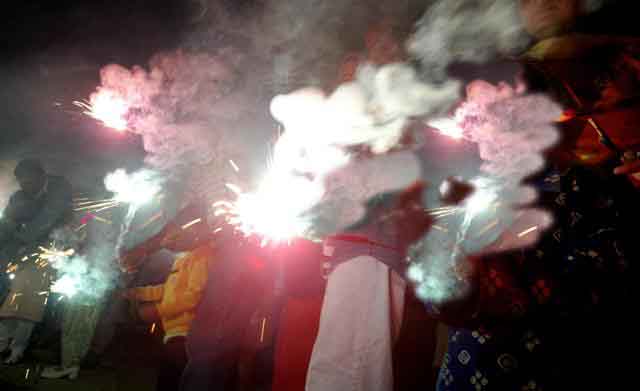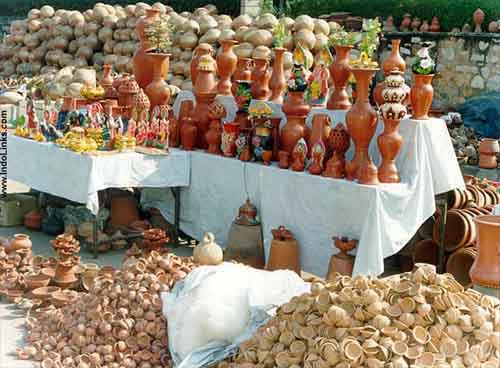 |

|
 |

|
 |
|
|
 India is a melting pot of races and religions. Every religion has its own unique style of celebration. But Diwali (Deepawali), the Festival of Light, is celebrated with fervor and gaiety among all races and religions. The festival symbolizes unity in diversity. The celebration of this five-day festival commences on Aswayuja Bahula Chaturdasi and ends on Kartika Shudda Vijiya. Hindus all over the world
celebrate Deepawali with great enthusiasm. This is a major Hindu festival
honouring Mother Lakshmi – the goddess of wealth. Diwali is a holy tradition,
not to be put in the shade. It symbolizes the victory of light over darkness;
darkness refers to ignorance and light refers to knowledge. Celebrated
joyously all over India, it is a festival of wealth and prosperity.
Diwali is a festival synonymous with celebrations in India and is an occasion for jubilation and togetherness. This is an occasion for people of all religions. At the metaphysical level, Deepawali is a festival signifying the victory of good over evil. People believe that the latter is destroyed and reduced to ashes by fireworks. This festival is celebrated on a grand scale in almost all regions of India and is looked upon mainly as the beginning of a New Year. On this day of Diwali (Deepavali) people light small oil lamps (called diyas) and place them around their homes, in courtyards, gardens, verandahs, on the walls and also on the roof tops. In cities, candles are substituted by diyas; and among the riches, candles are made to substitute for fashionable lights. The celebration of the festival is customarily accompanied by the exchange of sweets and lighting crackers. 
Kuber Temple |

click for Other Tourist Place |
How to do Diwali Lakshmi Puja CLEANING YOURSELF
Place One big diya,filled with ghee, on the plate of rice resting on top of the Kalash (this represents THE SUN). Together they represent MAHA LAXMI. It is customary to setthe pot on some grains of unbroken rice. This pot represents Varuna, the God ofthe Ocean. AND LAXMI as Mother Earth. Place the other big diya on your right hands side -this one is for arti the wicks should be of the rolled up type. Another diya should be kept on the side next to Ganesh. This can be a small one, with apulled up wick. This is for the purpose of performing arati later on. It should be placed on a small platter or tari on some rice. Place a lower platform before the one on which the icons and the big diyas are placed. The red cloth should be spread on thislower platform. Now fill the other 8 (diyas) with ghee and wicks and place them around the Kalash in a Half circle with the circle towards you. Each diya is placed on a rice platform. PERFORM SODASAMATRIKA PUJANAM
FIRST
The 16 mothers are represented on the platform by 16 small heaps of rice and a NUTMEG on top. Bowing to the 16 mothers,take rice, flowers and fragrance (atar) in your hands and say: GOURI PADMA SACIMEDHA SAVITRI
VIJAYA JAYA DEVASENA SVADHA
Gouri, Padma, Saci, Medha, Savitri, Vijaya, Jaya,Devasena, Svadha, Svaha, Mataro,Lokamatrah, Hrstih, Pustistatha, Tusti, Atmakuladevataare the sixteen venerable mothers. Take a handful of rice, and pouring it through yourfingers on the red cloth. This is the representation for various deities as explained below: Sprinkle the flowers, rice and fragrance (atar). MAHALAXMI PUJANAM (THE WORSHIP OF MAHALAKSMI) It is only now that Laxmi herself gets worshipped.Start on this confidently and happily. DHYANAM (MEDITATION) SRI MAHA-LAXMI STOTRAM Aum Namaste-astu mahaa-maaye sree peethe sur-poojite,Shankha chakra gaddaa-haste, Mahaa Lakshmi namo-astute. O Great Mother, abode of fortune, Who artworshipped by the Devas, I salute Thee; O Mahaa Laxmi, wielder of conch,disc and mace, obeisance to Thee. Aum Namaste garu-daaroode, kolaa-sura bhayankari;Sarva paapa hare devi, Mahaa Lakshmi namo-astute. My salutations to Thee, Who ridest the Garuda andart a terror to the demon Kola; O Mahaa Laxmi remover of all miseries, myobeisance to Thee. Aum Sarvagye sarva varde, sarva dustha bhayankari;Sarva duhkha hare devi, Mahaa Laxmi namo-astute. Salutations to Thee, Who knowest all, The Giver of all boons, a terror to all the wicked, remover of all sorrow, my obscene to Thee. Aum siddhi buddhi prade devi. bhukti-muktipradaayini; Mantra moorte sadaa devi, Mahaa Laxmi namo astute. O Goddess of Wealth, giver of intelligence andsuccess and of worldly enjoyment and liberation, Thou hast always the mystic symbols as Thy forms, O Mahaa Laxmi, obeisance to Thee. Aum Aadhyanta rahite devi, aadhya-shakte maheshvari;Yogaje yoga-sambhoote, Mahaa Lakshmi namo-astute. O Mother Maheshvari, without a beginning or anend; O Primeval Energy, born of Yoga; O Mahaa Laxmi, obeisance to Thee. Aum Stoola suksham mahaa rovdre, mahaa shaktemahodaye; Mahaa paapa hare devi, Mahaa Laxmi namo-astute. O Mahaa Laxmi, who art both gross and subtle,most terrible, great power, great prosperity and great remover of allsins, obeisance to Thee. Aum Padmaa sanas-thite devi, pare brahma svaroopini;Para meshi jagan-maatar, Mahaa Laxmi namo-astute. O Devi, seated on the lotus, who art The SupremeBrahman, The Great Lord and Mother of the Universe, O Mahaa Lakshmi, obeisanceto Thee. Aum Svetaambar dhare devi, naanaa lankaar bhooshite;Jagat stithte jagan maatar, Mahaa Laxmi namo-astute. O Devi, robed in white garments, and decked invarious kinds of ornaments, Thou art The Mother of the Universe and its support;O Mahaa Laxmi, obeisance to Thee. Aum Mahaa Laksham-yashtak stotram, yahahpathed-bhakti maan narah; Sarva siddhim vaapnoti, Mahaa Lakshmee prasaad taha. Whoever with devotion recite this hymn to SriMahaa Laxmi, composed in eight stanzas, attains all success through the Grace ofMahaa Laxmi Devi. Take flowers or unbroken grains of rice in yourhands. Meditate upon the goddess, saying: YA SA PADMA SANASTHA VIPULA
KATI TATI PADMA PATRAYAT AKSI
Laksmi who is seated on a lotus, has eyes as wideas lotus petals, massive hips, deep navel, and heave breasts, wears white upperand lower garments, wears jewelry, is bathed from a golden pitcher, carries alotus in her hand, and is associated with every auspicious sign, let her residein my house. Drop the flowers and the rice at the feet of the goddess. AVAHANAM (INVOCATION) Now you have to invoke Laxmi. Avahanam is the act of invoking her. Join your hands with palms upwards, only the little fingers touching ( with open palms). Make the usual gesture of welcoming guests in, andinvite Laxmi to the household, office or factory where she is going to be worshipped and say: OM SARVA LOKASYA JANANIM SULA HASTAM TRILO CANAMSARVADE VAMA YIMI SAM,DEVI MAVA HAYA MY AHAM DEVIM AVAHA YAMI SWAHA I invoke the mother of the three worlds, the three eyed one with the spear in her hand, in whom all the gods reside. I invoke the goddess. Now, Kalash Puja: KALASH (VARUNA) PUJA IS THE RE-CREATION OF THE EARTHLY YOURSELF AS BRAMHA Fill the kalasha with water. Offer sandalwood powder,flowers and tulasi to decorate it. Place a coconut on top of the vessel and putyour palms over the top of it while chanting the following mantras: THE KALASH REPRESENTS THE RE-CREATION OF THE NEWEARTH OR NEW KALAPURSHA BECAUSE YOU ARE NOT HAPPY WITH THE OLD EARTH OR OLDLIFESTYLE ON EARTH KALASHASYA MUKHAE VISHNUHU KANTAE RUDRAHASAMAASHRITAHAMULAE TATRA STHITHO BRAHMA MADHYAE MAATRAGANAHASMRITAHA We worship the kalasha (vessel above which the coconut is placed) invoking Mahavishnu at the mouth of the vessel. We invokeLord Rudra (an aspect of Shiva) at the neck of the kalasha and Brahma at thebase of the vessel. We invoke the Universal Mother Goddess and Her retinue in midst of the kalasha. Thus the male and female trinities are invoked. Salutations! AUM AAJIGHRI KALASHAM MAHYAATVAA-VINSHATVINDAVAHPUNROOJEE-NIVARTASYA SAANAH; SAHASRAMDHUKSHVORU-DHAARAAPAYASVATEE PUNARMAA VISHATAA-DRIYAH. AUM ATRA GANESH VARUNA GAURYA AADI KALSHAA DHISHTITDEVATAASARVEIHAAGACHCHANTU IHA TISHTANTU SUPREETAA VARDAA BHAVANTU.ITI KALASHPRATISHTAA SRI KALASH STHAAPYA SRI KALASH DEVATAA SRIVARUNA DEVATAAYEBHYO NAMAH. AVAHANA - Invocation -Place
the following ingredients on a pan leaf and insert into the Kalash
Chandan (brown Sandalwood
powder)
AUM YAH PHALY-NEERYAA APHALAA
APUSHPAA YAASHCHA PUSHPINI NOH;
Tie the thread on the Kalash - kaacha soot or Holythread is to be tied around the neck of the Kalash AUM YUVAA SUVAASAAHA PARIBEET-AAGAATSAUSREYAAN-BHAVATIJAAYAMAANAH;
KALASH PRARTHANA AUM KALASHSYA
MUKHEVISHNU KANTHERUDRAHSAMAASRITAH;
THE WORSHIP OF VARUNA With flowers in your hands, pray that your Earth has berenewed Now it is the turn of Varuna, the god of the Ocean.Varuna is represented by the water you have taken in the kalasa or pot. SoVarunapujana is also known as kalasapujana. Take some water in your hand andsay: KALASE VARUNAYA NAMAH SWAHA Invoking all the places of pilgrimage in thispot, I worship it and bow to it. NOW THE NINE FORMS OF LAXMI ARE WORSHIPED - THE 8DIYAS AND THE ONEIN THE MIDDLE KNOWN AS MAHALAXMI. Do the following while chanting the mantra: Bring the deity alive - by pouring with a spoon,Panch Amritam (mixture of 5 ingredients)??????.Aum Panch-aaamriten pas-chaach chuddod-ken Shri LaxmiMata samarpa-yaami swaha Offering a Seat to the deity...............AumIdam aasaanam Shri Lammi Mata samarpa-yaami swaha Touching the feet of the deity...........AumPaada-yoha paadyam Shri Lammi Mata samarpa-yaami swaha Giving deity water to drink...............AumHastayor-arghyam Shri Lammi Mata samarpa-yaami swaha Purifying area around deity with water.....AumMukhe aachman-eeyam Shri Lammi Mata samarpa-yaami swaha Energizing the deity with fluid...........AumSnaanaar-tham jalam Shri Lammi Mata samarpa-yaami swaha Now place all items on a Pan Leaf and offer to each,saying the mantra along: Vastram (Silk Cloth)................ AumVastram Shri Lammi Mata samarpa-yaami swaha Kacha Soot (Holy Thread)............AumYajno-paveetam Shri Lammi Mata samarpa-yaami swaha Attar (Perfume).............................AumGandham Shri Lammi Mata samarpa-yaami swaha Chandan (Brown Sandalwood).....AumChandanam prati grihayatam Shri Lammi Mata samarpa-yaami swaha Sindoor (Red Sandalwood)............AumSindooram Shri Lammi Mata samarpa-yaami swaha Hardee (Yellow Tumeric)..............Aumhaldeeyam Shri Lammi Mata samarpa-yaami swaha Gingelly (White Sesame Seeds)...Aumgingelly Shri Lammi Mata samarapa-yaami swaha Akshat (White Uncooked Rice)....Aumakshataya Shri Lammi Mata samarapa-yaami swaha Dhan (Unshelled Rice).................Aumdhanam Shri Lammi Mata samarapa-yaami swaha Kapoor (Camphor).......................Aumkapoor Shri Lammi Mata samarpa-yaami swaha Lawang (Cloves)..........................Aumlavang Shri Lammi Mata samarpa-yaami swaha Elaichi (Unshelled Cardamom)......Aumelaichi Shri Lammi Mata samarpa-yaami swaha Supari (Betel Nuts)......................Aumtaam-boolam Shri Lammi Mata samarpa-yaami swaha Ritu-Ohal (Grapes or Raisons)....Aumritu-phalam Shri Lammi Mata samarpa-yaami swaha Pushpam (White Flower)...............Aumpushpam Maalam Shri Lammi Mata samarpa-yaami swaha Neemam (Neem Leaf)..................Aumneemam Shri Lammi Mata samarpa-yaami swaha Tulsi ...............................................Aumtulsee-dalam niveda-yaami Shri Lammi Mata samarpa-yaami swaha Durva Grass (Special Grass)........Aumdhubam Shri Lammi Mata samarpa-yaami swaha Naivediam (Mixture of Sugar, Milk Cream &Honey)..Aum Naivedyam Shri Lammi Mata samarpa-yaamiswaha Coins (silver).............................Aumdakshinaam Shri Lammi Mata samarpa-yaami swaha With an incense arti the deity..Aumdhoopamaa-ghraa-payaami Shri Lammi Mata samarpa-yaami swaha With a diya arti the deity........Aumdeepam darsha-yaami Shri Lammi Mata samarpa-yaami swaha Circle the deity with the arti of light.......Aumkarpoor-aaraarti-kayam Shri Lammi Mata samarpa-yaami swaha..................................................................Aumpra-dakshinaam Shri Lammi Mata samarpa-yaami swaha "Samarpa-yaami" means not for me but for you God Recite Mahalaxmi Bhajan &
Aarti after performing this.
|
| DIWALI FAQ
What is the meaning of
Diwali or Deepawali?
How do people celebrate
Diwali in India?
What can I do for my Indian
friends to show my appreciation and celebrate Diwali with them?
In India, Diwali is very commercialized, people spend lots of money on buying new dresses, saris, salvaar kamiz, pavada davani (skirt and top), lengha, dhotis, kurta pajama, etc for the girls and boys, men and women. People even buy new gifts for the newlyweds. Diwali is traditionally a time that the newlyweds come to their inlaws, in particular the newlyweds go to the bride's family home to collect gifts, including relatively inexpensive gifts from sweets and clothes to very expensive gifts like gold, cars and even land and property. What are some religious
aspects of Diwali?
However, there is one tradition
which is special to the state of West Bengal (Calcutta is in this state),
they have special pujas for Kali. It is even said that in these pujas they
use fish
|
 |